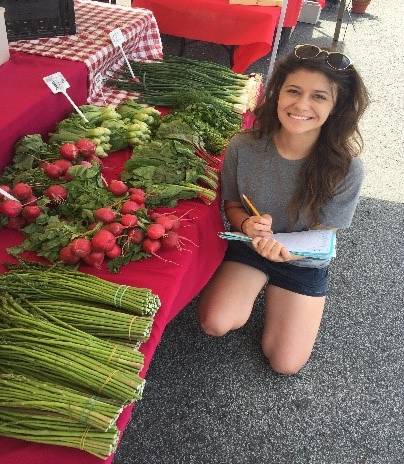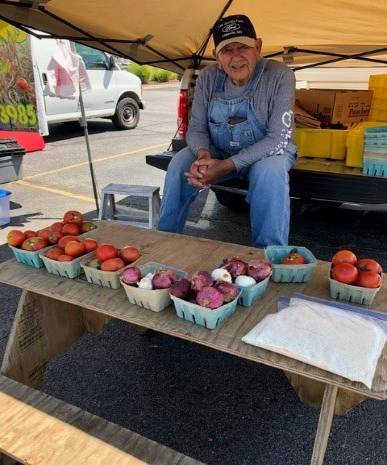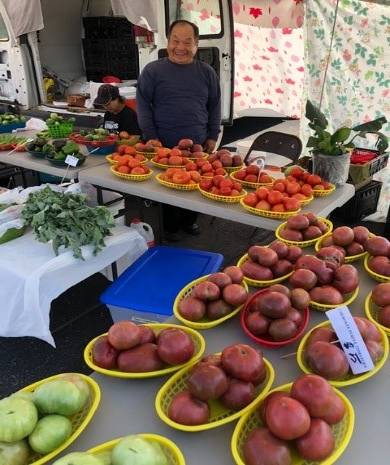
Anticipating Farmers Market Surplus for Value-Added Production
Here is a guest post from graduate student Morgan Gramlich and the research she did this summer tracking farmers market trends to determine the potential for producing value-added foods!



Picture 1-3: Morgan Gramlich collecting data at "The Original Rogers Farmers Market in 2019 (left); tomato vendor selling produce at "The Original Rogers Farmers Market" in 2019 (middle); vendor proudly displays a large array of produce at "The Original Rogers Farmers Market" in 2019 (right).
My name is Morgan, and I am a Masters graduate student in the Department of Horticulture at the University of Arkansas. The purpose of this study was to track farmers market trends (produce availability, number of vendors selling a given produce item and produce price) in order to determine the potential for producing value-added foods (jam, jelly, salsas, etc.) from farmers market surplus. Our goal is to reduce food waste and create value added products farmers or farmer markets could sell to increase revenue. The data collected was used to determine what produce would most likely be seen in surplus at a farmers market and when during the market season it would be available at the lowest cost. The farmers market studied was The Original Rogers Farmers Market located in Rogers, Arkansas. Recommendations for potential value-added food products were made through the interpretation of data collected from this market.
Materials and Methods
The Original Rogers Farmers Market has about 20 total vendors from Arkansas and Oklahoma, and 4-8 of these vendors sell produce. Data was collected on market days (Wednesdays and Saturdays) for fourteen weeks (May 18-Aug. 1) during the 2019 market season. A visual evaluation of produce availability and price for each produce item was collected during every market. The number of times produce vendors had items for sale (estimate of availability) and the price of those items throughout the season was evaluated. Availability was calculated as number of vendors selling a given item (%) multiplied by the number of markets out of the total (%) in which the item was available. Data for the market season was used to determine what value-added products would be the lowest cost to develop given produce availability, number of vendors selling the item (estimated volume) and produce price.
Farmers Market Anticipated Surplus
There were over 66 produce items available throughout the market season. Table 1 shows the top 10 most available produce items (squash, cucumber, zucchini, tomato, potato, bean, onion, green onion, kale, garlic) at the market based on the number of times the item was available for sale and the number of vendors selling the item. Of these produce available, squash, cucumber, zucchini, tomatoes and potatoes were the top five most available produce items (over 59%).
Table 1. Availability of various produce items for sale during the 2019 market season at “The Original Rogers Farmer’s Market”, Rogers, AR May 17-Aug. 1, 2019. Availability based on number of vendors and number of markets at which the item was available for sale.
Seasonal trends for the top five most available crops were evaluated. Then this data was used to determine what weeks had the highest number of produce vendors with the specific item, and what weeks had the lowest prices for those items.
Number of Produce Vendors Selling Items
The percent of vendors selling the five most available produce items by week were evaluated (Fig. 1). There were many weeks where most produce vendors had squash and zucchini. Generally speaking, from mid-June to mid-July there were consistently about 80% of produce vendors with squash and zucchini at every market. From July 3rd until July 10th 100% of produce vendors at the market had cucumbers; from July 10th to Aug 1st more than 85% of produce vendors had tomatoes at every market; and 100% of vendors had potatoes on May 25th.
Figure 1: Percent of vendors selling the five most available produce items by week at "The Original Rogers Farmer's Market", Rogers, AR (May 18-Aug. 1, 2019)
Average Price Per Market
The prices of the top five most available produce items were also evaluated by week (Fig. 2). The prices of the produce ranged from $1.64/lb. to $6.00/lb. The data collected showed that squash and zucchini had the lowest price on July 17th and July 20th at $2.06/lb.; cucumbers were the lowest priced on July 6th at $1.64/lb.; tomatoes were at their seasonal low from June 29th to July 6th at $2.05-2.13/lb.; and potatoes experienced their seasonal low on July 27th at $4.80/lb.
Fig 2. Average price per pound of the five most available produce items by week at “The Original Rogers Farmer’s Market”, Rogers, AR (May 18-Aug 1, 2019)
Recommendations Based on Evaluation
The data showed that squash, cucumber, zucchini, tomatoes and potatoes were the most commonly sold produce items and sold by the greatest number of vendors meaning they are likely to be in surplus and be available for use in value-added food production.
Based on our data collection the optimal time to purchase squash, zucchini, cucumbers, and potatoes at low cost is from June 29th-July 10th. Squash and zucchini did not experience their seasonal lowest price ($2.06) until late July. However, from July 17th- July 27th less than 50% of produce vendors were supplying the market with squash and zucchini. Therefore, it was determined the optimal purchasing time for these produce items was from June 29th-July 10th when more than 75% of produce vendors had squash and zucchini for a marginally higher price ($2.16-$2.55). Potatoes did not experience their seasonal low until late July ($4.80). However, the price of potatoes was consistently lower than average ($5.10-$5.61) from June 29th-July 10th and a larger percentage of produce vendors had potatoes consistently during this time (<60%). During this time period there were also more than 80% of produce vendors selling cucumbers for their lowest purchasing price of the season ($1.64-$1.87).
It was determined that the optimal time to purchase tomatoes was July 13th-July 20th. Even though the lowest price for tomatoes occurred from June 29th- July 6th ($2.05-$2.13), from July 13th-July 20th there were twice as many produce vendors selling tomatoes (<87%) for only a slightly higher price ($2.28). The higher percentage of produce vendors selling tomatoes at this time indicates a higher likelihood for surplus produce.
It is recommended to develop products that contain large quantities of these produce items because of the significant discount produce vendors are willing provide when they have surplus. Examples of economically feasible value-added products that could be produced from these items include tomato sauce, salsa, or flour.
In 2018 our project bought excess produce from The Original Roger Farmers Market and developed a few value added products. For more information on this project, please visit:
https://www.uaex.uada.edu/media-resources/news/may2018/05-22-2018-Ark-Farmers-Market-Surplus.aspx